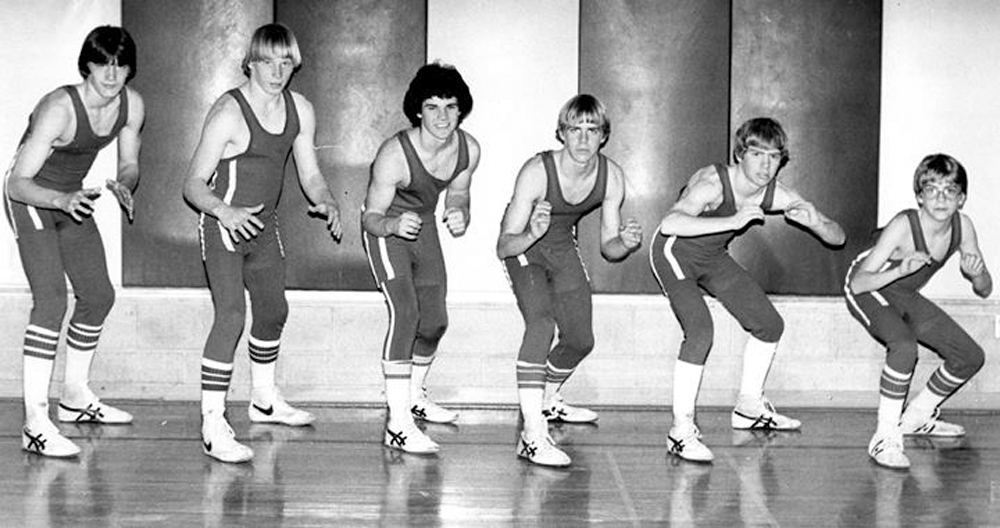Lee says the jeans “recall the seventies porno scene.” Most are depicted without people in them, but they’re weirdly shapely, definitely filled out. There are butts in those jeans. “Of course!” says Lee. “But that’s what I love about them, that was the era.”
Pencil scrawls on the walls of the gallery denote each work. Some of those pencilings are a work themselves, such as “He’s Not, as dictated, but not necessarily pertaining to, Paul M. Hopkin,” by Judith Brotman.
Lee explains, “She’s asked Paul to do a Bart Simpson, if you will, to write on the blackboard.” The wall is a cloud of He’s Not’s, imagined by Brotman and inscribed by Paul. He’s not languid, he’s not dead, he’s not phantasmagoric. “It’s kind of a weird self portrait,” says Lee, “because you’re not sure of how objective or subjective it is, because of the way that she dictated to him.”
Lee could himself give a pretty good portrait of Paul. They’ve been friends for two decades; in the nineties they attended the School of the Art Institute of Chicago together. “He was in ceramics, I was in sculpture. He was the technician, I was the weird conceptualist who didn’t do a lot of work, and we’ve—” Lynde’s sculpture falls over before he can finish the thought, and Lee dives to reset it.
I ask Lee if his decades of knowing Paul prove any of the phrases on the wall untrue. “No,” he says, but after pausing to read, he takes his “no” back on some accounts. “Well, he’s definitely not dead,” Lee says. “He’s not giddy? No, he is. He’s not obvious? He can be. He’s not me—well that’s a fact. He’s not cranky? It depends on when.” Among the more obviously true is “He’s not alone.”
Slow Gallery opens directly into Hopkin’s apartment, and on opening night the back room is full of friends talking and toasting with gin and homemade tonic.
Early on, Lee jokes that the show is a weak excuse to celebrate Slow’s five years, though the technical anniversary is a few months off. “This is a love-fest for Paul, it’s an homage, it’s a tribute,” says Lee. And it is clear that we are among friends. Many guests took part in the gallery’s inaugural roundup, five years ago. Both Paul and Lee are frequently interrupted by friends coming or going, and there’s a lot of clapping and laughter. But both curator and subject are thoughtful about the other questions the show poses: questions about art, and curation, and the ways in which perceptions of sexual identity have shifted, or not.
As the show’s tongue in cheek subject, Paul’s sexuality comes up as he talks about the art, and he moves fluidly between the two. “I’m not a vulnerable gay,” he says, in the midst of an analysis of a favorite piece. “It’s easy for me to be gay. I’m white. I went to a good graduate school. I’m in the art world.” But he’s concerned that the images associated with being gay haven’t changed.
The piece we’re looking at, “Rebis Rebus,” is a sort of charcoal pencil drawing by Ryan Michael Pfeiffer and Rebecca Walz. It’s a melee of images, various scribbled sex acts mingled with faces that look like they’ve been peeled off a Mesopotamian vase. “While I’m interested about how much an identity changes when we don’t acknowledge that it changes, she’s referring to things that are thousands of years old, but still from a fresh perspective,” continues Paul. But he also likes it because it’s direct, sexy, and beautiful. “I can just look at it, and respond to it. I don’t have to think about it. It does things without me feeling this impulse to explain.”
The art of “Paul’s NOT Gay” is the kind of work that can be laughed with, not at. The kind that can be read, examined, watched on repeat, participated in. “I’m an intellectual in a lot of ways, but I’m an artist because that experience outweighs the intellectual aspect,” says Paul. “No matter how intellectual I am, I want the art to win.”
Slow Gallery, 2153 W. 21st St. Through March 14. Saturdays, noon-5pm. (773)645-8803. paul-
This story has been revised to reflect the following correction:
Correction: February 19, 2014
Due to an editing error, the print version of this story misattributed the authorship of a pamphlet about Paul Hopkin. The pamphlet, which illustrated a story from Hopkin’s childhood, was created by Andrew Holmquist; it was not co-authored with John Henley. The print version of this story also did not include attribution for the artwork “Paul Lynde to Block,” by Steve Reber.



